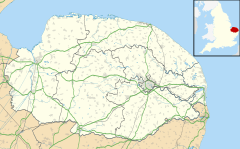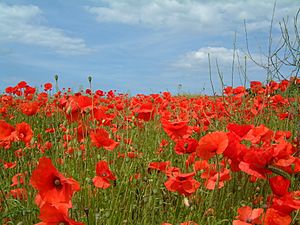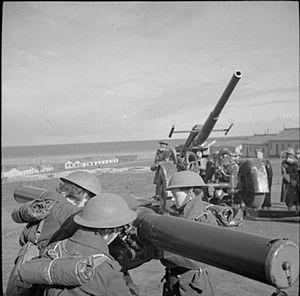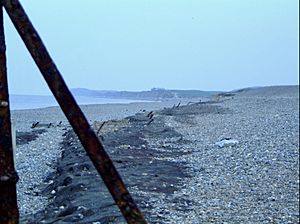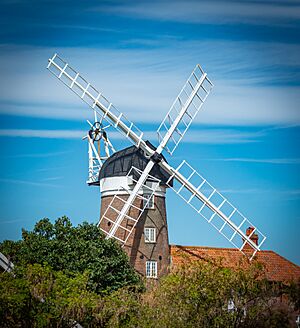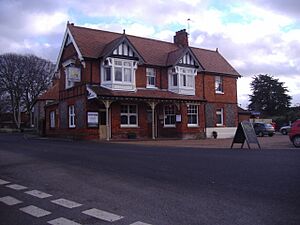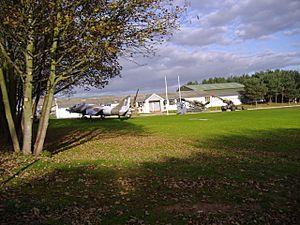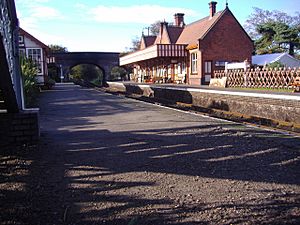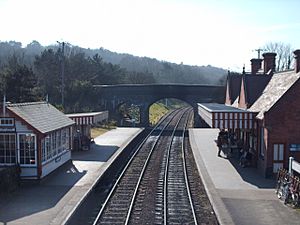Weybourne, Norfolk facts for kids
Quick facts for kids Weybourne |
|
|---|---|
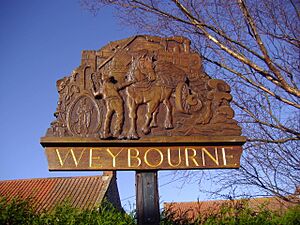 The village sign |
|
| Area | 6.91 km2 (2.67 sq mi) |
| Population | 543 (2011 census) |
| • Density | 79/km2 (200/sq mi) |
| OS grid reference | TG1143 |
| • London | 131 miles (211 km) |
| Civil parish |
|
| District | |
| Shire county | |
| Region | |
| Country | England |
| Sovereign state | United Kingdom |
| Post town | HOLT |
| Postcode district | NR25 |
| Dialling code | 01263 |
| Police | Norfolk |
| Fire | Norfolk |
| Ambulance | East of England |
| EU Parliament | East of England |
| UK Parliament |
|
Weybourne is a small village located on the coast of North Norfolk, England. It's surrounded by open fields, forests, and heathland. The village sits right on the A149 coast road, about 3 miles (5 km) west of Sheringham. It's part of the beautiful Norfolk Coast AONB, which means it's a special area of natural beauty.
People love visiting Weybourne for its amazing countryside and coastline. It's a great spot for walking, seeing local wildlife, and especially for bird-watching.
The old church, All Saints, is a very important historic building. The nearby ruins of the Augustinian priory are even older and are protected as a Scheduled Monument.
Contents
- What's in a Name? The Story of Weybourne
- Weybourne's Weather
- A Look Back: Weybourne's Early Days
- Weybourne in World War II
- Village Life: Shops and Pubs
- Explore Military History: The Muckleburgh Collection
- All Aboard! The North Norfolk Railway
- The Coastline: Smugglers and Shipwrecks
- Famous Faces in Weybourne
- Images for kids
- See also
What's in a Name? The Story of Weybourne
The name of Weybourne is a bit of a mystery! The second part, "bourne," definitely means 'stream' or 'river'. The first part, "Wey," could be an old river name from before English was spoken here. It might also mean 'weir' or 'mill-dam stream'. There's an old mill pond here, but we don't know how old it is. Other ideas for the name are less likely.
Weybourne's Weather
Weybourne has a mild oceanic climate. This means it usually has cool summers and mild winters, with rain throughout the year.
| Climate data for Weybourne (21 m or 69 ft asl, averages 1991-2020) | |||||||||||||
|---|---|---|---|---|---|---|---|---|---|---|---|---|---|
| Month | Jan | Feb | Mar | Apr | May | Jun | Jul | Aug | Sep | Oct | Nov | Dec | Year |
| Mean daily maximum °C (°F) | 7.4 (45.3) |
7.8 (46.0) |
9.8 (49.6) |
12.5 (54.5) |
15.3 (59.5) |
18.4 (65.1) |
20.8 (69.4) |
21.0 (69.8) |
18.4 (65.1) |
14.6 (58.3) |
10.6 (51.1) |
8.0 (46.4) |
13.7 (56.7) |
| Mean daily minimum °C (°F) | 2.7 (36.9) |
2.6 (36.7) |
3.9 (39.0) |
5.8 (42.4) |
8.4 (47.1) |
11.2 (52.2) |
13.4 (56.1) |
13.6 (56.5) |
11.7 (53.1) |
9.1 (48.4) |
5.6 (42.1) |
3.2 (37.8) |
7.6 (45.7) |
| Average rainfall mm (inches) | 53.6 (2.11) |
41.5 (1.63) |
42.5 (1.67) |
39.6 (1.56) |
41.8 (1.65) |
53.3 (2.10) |
54.2 (2.13) |
57.6 (2.27) |
53.2 (2.09) |
66.6 (2.62) |
71.3 (2.81) |
61.7 (2.43) |
636.9 (25.07) |
| Average rainy days (≥ 1 mm) | 11.3 | 10.3 | 9.1 | 8.5 | 7.9 | 8.9 | 9.1 | 9.2 | 9.0 | 11.2 | 12.4 | 12.7 | 119.6 |
| Source: Met Office | |||||||||||||
A Look Back: Weybourne's Early Days
Weybourne is mentioned in a very old book called the Domesday Book, from 1086. Back then, it was called Wabrume.
The ruins you can see today are from Weybourne Priory. This priory was a type of monastery, built around 1200 AD. It was founded by a person named Sir Ralph de Meyngaren. It was built on the site of an even older Anglo-Saxon church.
By the late 1400s, only a few monks lived there. It was so poor that one monk even complained he wasn't getting his small allowance! By 1514, there were only two monks left. This continued until King Henry VIII ordered all monasteries to close.
Weybourne in World War II
Protecting the Coast: Wartime Defences
Weybourne has always been seen as a possible place for invaders to land. This is because the water offshore is quite deep. There's even an old saying: "He who would all England win, should at Weybourne Hope begin."
During the Second World War, many defences were built around Weybourne. These were part of Britain's plan to stop an invasion. The beaches were covered with landmines and tall metal barriers. Further inland, there were small concrete bunkers called pillboxes, lots of barbed wire entanglements, and a long ditch to stop tanks.
Weybourne Camp: A Secret Training Ground
During the war, Weybourne Camp was a very secret place. It was a training ground for Anti-Aircraft Artillery. This camp, along with another one nearby, was where soldiers learned to fire anti-aircraft guns. The Norfolk coastline became a special controlled zone, stretching 10 km (6 mi) into the North Sea. Weybourne Camp was a key part of this important defence area.
Winston Churchill, who was the Prime Minister, visited Weybourne Camp twice in 1941. These visits happened after the Dunkirk evacuation, when Britain was on high alert. During his first visit, a gun firing demonstration didn't go well. Churchill gave the camp leader only seven days to improve! On his second visit, things still went wrong until a special pilotless target plane was finally shot down. It crashed near where the important visitors were standing. It's said that all the senior staff at the camp were replaced the next day!
The Mystery of the Windmill and the Rumoured Spy
Weybourne Windmill is a beautiful old tower mill built in 1850. It has been fixed up, but it doesn't work as a mill anymore. During the Second World War, people in the village became suspicious of the couple living at the windmill. There were whispers that they might be spying for the Germans. The man was Mr. Dodds, and his wife reportedly had a strong foreign accent.
One night, two local policemen saw a light flashing from the top of the windmill out towards the sea. Strangely, nothing happened at first, even though it was wartime and so close to Weybourne Camp. But one policeman was still worried. A few nights later, he went back and saw the lights again.
Some time later, Mrs. Dodds left her bicycle outside the tennis court. It fell over, and a bag dropped out of the basket. A local person picked up the bicycle and the bag. They looked inside the bag and found a radio transmitter! They told the police, and a day or two later, the authorities arrived and took the couple away.
Weybourne also had an old watermill on Beach Road.
Village Life: Shops and Pubs
In Weybourne, you can find Weybourne Stores, which is a local shop. There's also The Ship public house, a traditional pub that serves drinks and hot food for lunch and dinner. Just a short walk from the village centre is the Maltings Hotel, which also has a bar and restaurant, and offers rooms to stay in.
Explore Military History: The Muckleburgh Collection
A popular place to visit is the Muckleburgh Collection. This is the biggest private collection of tanks, armoured cars, and other military vehicles from wars around the world. It's a fascinating place to learn about military history!
All Aboard! The North Norfolk Railway
Another great local attraction is the North Norfolk Railway. This historic railway, also known as the "Poppy Line," runs from Sheringham through Weybourne to Holt. It's a well-preserved railway that travels through the beautiful countryside east of Weybourne. You can see the carefully kept country station, which also has a shed for trains and a centre for fixing old carriages.
The railway offers a 10.5-mile (16.9 km) round trip. You can ride on a classic steam train or, on some days, a vintage diesel train. The journey takes you through an area of North Norfolk that is so beautiful it's called an Area of Outstanding Natural Beauty.
Weybourne Railway Station: A Step Back in Time
Weybourne railway station is about 1,000 yards (910 m) from the village centre. You can find it by following signs from the coast road, opposite the church. The main station building was built in 1900. Other parts of the station, like the signal box, waiting room, and footbridge, were brought here from other places to make it look like it did in the past.
When the railway line closed, the tracks were removed, and most of the station was taken down, except for the main building. The station was used for filming an episode of the TV show Dad's Army called "The Royal Train". It's still often used by filmmakers and artists today. At the station, there's a small shop, a place to get food, and a picnic area. On weekends, there's a bookshop selling old railway books, magazines, videos, and CDs.
The Coastline: Smugglers and Shipwrecks
Weybourne's coast has a very steep shingle beach. Because of this, it was once thought to be an easy place for invaders to land, even back in 1588 during the time of the Spanish Armada.
The village was also a popular spot for smuggling! People would secretly bring in goods like strong gin and tobacco. The coast between Sheringham and Weybourne was good for landing goods because ships could get closer to the shore here than anywhere else nearby. There was also a handy gap in the cliffs to move the goods easily.
Local stories say that the miller at Weybourne Windmill would stop the windmill's sails in the shape of a cross. This was a secret signal to warn smugglers that customs officers or coastguards were nearby. When the coast was clear, he would start the sails moving again. On Weybourne beach, there wasn't much cover for the people waiting to collect the smuggled goods. It's said that they would bury themselves up to their necks in the shingle until the smuggling ship appeared! This story might be a bit hard to believe, but it's also told about other places, which makes it interesting.
In the 1800s, the owner of Weybourne watermill, William J. Bolding, was said to ignore the smuggling happening on his land. In return, he would find secret packages of illegal goods left on his doorstep. In 1837, a group of coastguards from Weybourne caught a large gang of armed smugglers nearby. There was a shootout, and the coastguards managed to get five horses with carts carrying 540 imperial gallons (2,500 L) of brandy and about 4,000 pounds (1,800 kg) of tobacco.
Volunteers at the Rocket House helped save many sailors from ships that crashed along the Weybourne coast. However, the crew of the coal ship Emily were not so lucky; everyone but the captain was lost. In 1823, a ship from Naples carrying olive oil broke apart, but six of its crew were saved. When the Norwegian ship Ida was wrecked, all its crew were rescued using a special rocket line. The crew and some villagers saved some of the ship's timber, and it's said that some of these wooden beams are still in barns and cottages around Weybourne today. In January 1915, the bodies of six sailors from the SS George Royle washed up on Weybourne beach. There's a tombstone in the churchyard to remember them. The Rocket House is still standing, but it's now a private home.
Because of changes in government rules, the coastline in North Norfolk is no longer actively protected from coastal erosion.
Famous Faces in Weybourne
- Sir John Major, who was the Prime Minister of the United Kingdom from 1990 to 1997, owns a house in Weybourne.
- Benjamin Pulleyne, who was the Vicar of Weybourne from 1845 to 1861, was also the headmaster of Gresham's School.
Images for kids
See also
 In Spanish: Weybourne para niños
In Spanish: Weybourne para niños


